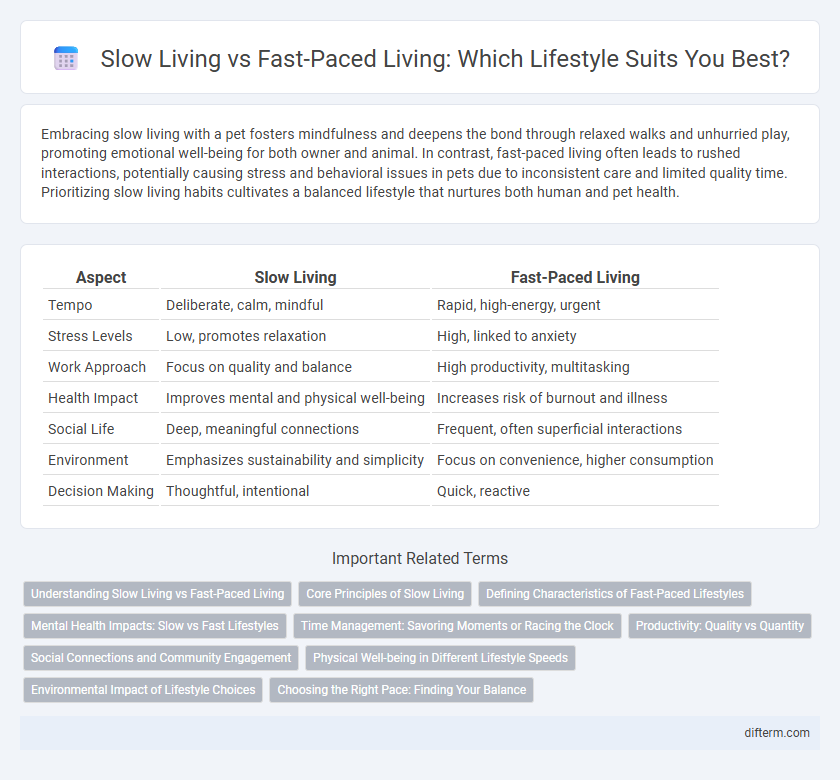Embracing slow living with a pet fosters mindfulness and deepens the bond through relaxed walks and unhurried play, promoting emotional well-being for both owner and animal. In contrast, fast-paced living often leads to rushed interactions, potentially causing stress and behavioral issues in pets due to inconsistent care and limited quality time. Prioritizing slow living habits cultivates a balanced lifestyle that nurtures both human and pet health.
Table of Comparison
| Aspect | Slow Living | Fast-Paced Living |
|---|---|---|
| Tempo | Deliberate, calm, mindful | Rapid, high-energy, urgent |
| Stress Levels | Low, promotes relaxation | High, linked to anxiety |
| Work Approach | Focus on quality and balance | High productivity, multitasking |
| Health Impact | Improves mental and physical well-being | Increases risk of burnout and illness |
| Social Life | Deep, meaningful connections | Frequent, often superficial interactions |
| Environment | Emphasizes sustainability and simplicity | Focus on convenience, higher consumption |
| Decision Making | Thoughtful, intentional | Quick, reactive |
Understanding Slow Living vs Fast-Paced Living
Slow living emphasizes mindfulness, intentionality, and prioritizing well-being by reducing stress and avoiding the constant rush associated with fast-paced living. Fast-paced living often involves multitasking, high productivity demands, and continuous connectivity, leading to burnout and decreased life satisfaction. Understanding these contrasting lifestyles highlights the importance of balance and conscious choices to improve mental health and overall quality of life.
Core Principles of Slow Living
Slow living emphasizes mindfulness, intentionality, and connection to the present moment, promoting well-being through reduced stress and increased focus on meaningful experiences. Core principles include simplifying daily routines, prioritizing quality over quantity, and nurturing deep relationships. This lifestyle encourages conscious consumption, sustainable practices, and a balanced pace that fosters mental clarity and physical health.
Defining Characteristics of Fast-Paced Lifestyles
Fast-paced lifestyles are characterized by constant multitasking, high-stress levels, and a relentless focus on productivity and efficiency, often leading to burnout and reduced well-being. Individuals in such lifestyles prioritize rapid decision-making, digital connectivity, and a fragmented attention span, which can hinder deep focus and meaningful personal connections. This mode of living contrasts sharply with slow living, where mindfulness, intentionality, and balance are emphasized for improved mental and physical health.
Mental Health Impacts: Slow vs Fast Lifestyles
Slow living fosters improved mental health by reducing stress, enhancing mindfulness, and promoting deeper connections, while fast-paced living often leads to chronic stress, anxiety, and burnout due to constant high demands. Studies show that individuals practicing slow living report greater emotional resilience and overall well-being compared to those in high-pressure environments. Emphasizing intentional, relaxed routines can mitigate mental health issues commonly associated with rapid lifestyles.
Time Management: Savoring Moments or Racing the Clock
Slow living encourages mindful time management by prioritizing savoring moments and reducing stress, fostering deeper personal connections and improved well-being. Fast-paced living drives individuals to race the clock, often leading to multitasking, burnout, and diminished presence in daily activities. Effective time management in slow living enhances productivity by focusing on quality over quantity, promoting balance and intentionality in everyday routines.
Productivity: Quality vs Quantity
Slow living emphasizes producing high-quality work by fostering mindfulness and reducing distractions, which enhances deep focus and creativity. Fast-paced living often prioritizes quantity and speed, leading to multitasking and burnout that negatively impact overall productivity. Balancing these approaches allows individuals to maintain steady output while ensuring meaningful and effective results.
Social Connections and Community Engagement
Slow living fosters deeper social connections by encouraging meaningful interactions and prioritizing quality time with family and friends, which strengthens community bonds. In contrast, fast-paced living often leads to fragmented relationships due to constant busyness and digital distractions, weakening social engagement. Embracing slow living enhances mental well-being and creates more opportunities for active participation in local events and communal support networks.
Physical Well-being in Different Lifestyle Speeds
Slow living promotes physical well-being by reducing stress levels, improving sleep quality, and encouraging mindful eating habits that enhance digestion and nutrient absorption. In contrast, fast-paced living often leads to chronic stress, poor sleep patterns, and unhealthy dietary choices, increasing the risk of cardiovascular diseases and weakened immune function. Adopting a slower lifestyle supports balanced hormone levels and sustained energy, fostering long-term health and resilience.
Environmental Impact of Lifestyle Choices
Slow living reduces carbon footprints by encouraging mindful consumption and lower energy use, significantly lessening environmental degradation. Fast-paced living often leads to overconsumption, increased waste production, and higher greenhouse gas emissions due to frequent travel and reliance on disposable goods. Choosing sustainable habits associated with slow living supports biodiversity preservation and promotes resource conservation.
Choosing the Right Pace: Finding Your Balance
Choosing the right pace in life requires understanding the benefits of slow living, such as reduced stress and increased mindfulness, versus the efficiency and excitement of fast-paced living. Embracing slow living promotes deeper connections and sustainable habits, while fast-paced living can drive productivity and dynamic opportunities. Balancing these lifestyles involves tailoring daily routines to personal wellbeing and goals, ensuring a harmonious rhythm that supports mental and physical health.
slow living vs fast-paced living Infographic

 difterm.com
difterm.com